The Geological Origin of Natural Diamonds
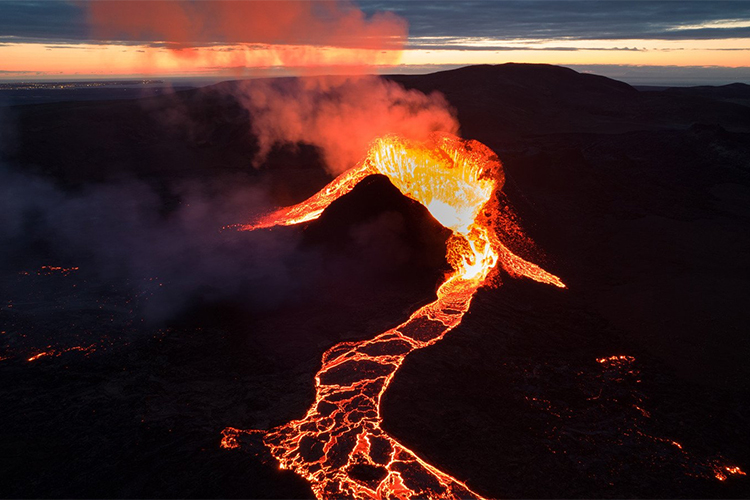
Diamond is a mineral composed of mainly of pure carbon, and the arrangement of carbon atoms within the crystal is almost perfectly symmetrical. Gem quality diamonds are typically 99.95% carbon and can be up to 99.99% pure. This makes diamond one of the purest of all gems found in nature.
The other 0.01% to 0.05% of a diamond’s chemical composition can include other trace elements that are not a part of the diamond’s essential chemistry. These trace elements can cause diamonds to be different colors, to fluoresce, or have other unique properties which we will explore in subsequent articles.
Long before there was life on Earth, there were diamonds. The age of the Earth is estimated to be 4.543 billion years old, and the oldest diamonds crystallized around 3.5 billion years ago. Approximately 100 miles beneath the surface of the earth, in rare conditions, extreme temperatures and pressures bonded carbon atoms tightly together, resulting in the hardest natural mineral on Earth: diamond. Diamonds are the oldest thing most of us will ever hold or own.
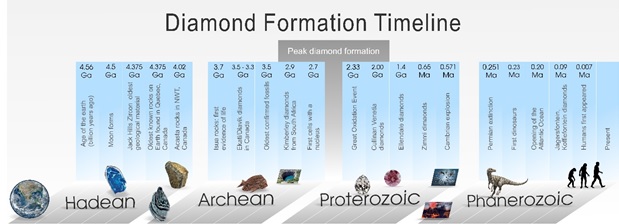
Diamond crystallization requires temperatures between 900° C to 1,300°C (2,200 F° – 2,700 F°), and a pressure of 725,000 pounds per square inch (psi). That’s the same amount of pressure that the Eiffel Tower would exert if it were turned upside down and barrowed at its tip to fit on a postage stamp!
Geology
Most diamonds crystallized just below the Earth’s crust in the upper mantle, between 70 and 120 miles (120 and 200 km) beneath the Earth’s surface. The region where the pressures and temperatures are just right for diamonds to form is called the diamond stability field.
There are two main modes of diamond formation that form at different depths. They either form under the roots of the continents called “cratons”, where they are carried to the surface of the Earth by rare volcanic eruptions carrying the host rocks, either kimberlite or lamproite – two of the deepest-sourced volcanic rocks that occur at the Earth’s surface. These diamonds form in or near the lithosphere, where the crust meets the upper mantle.
Some diamonds, however, form much, much deeper in the Earth, closer to the lower mantle, and are then transported to shallower depths through convection and brought to the surface via volcanic eruptions. These diamonds are called “super deep” diamonds.
FACT: The carbon that formed diamonds came from two sources. Most of the carbon was trapped in the Earth during the planet’s formation. However, a small percentage of carbon is “recycled”. It gets carried down from the surface of the Earth by a geologic process known as subduction. This happens when one section of the Earth’s crust slips under another and moves downward until it melts. The carbon is carried down from rocks in the crust.
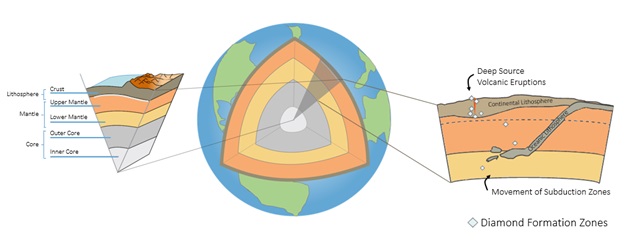
In the diagram above, the left is the structure of the Earth, showing the different layers. Diamond mainly forms below the crust and in the upper mantle. On the right, one part of the Earth’s crust slips under another and moves downward until it melts (a process known as subduction). Carbon that is present may form diamonds.
Diamond crystals grew at different rates, but scientists still do not have a clear picture of the exact growth rate of the diamond crystal, or diamond placement (when they erupted toward the surface). Some diamonds were carried upward soon after formation. Others remained stored in the Earth for millions of years.
Diamonds are carried up to the surface by magmatic eruptions, however, not all eruptions from deep inside the Earth pass through diamonds fields. This is why natural diamonds are so rare – there are only about 50 viable diamond mines in the world, and the last known eruptions that carried diamonds to the surface of the Earth occurred about 25 million years ago.
One final way diamonds can be formed is through the impact of meteors. In fact, diamond scientists used the information from diamonds found at meteorite impact sites to determine the conditions that may contribute to their growth in a laboratory!
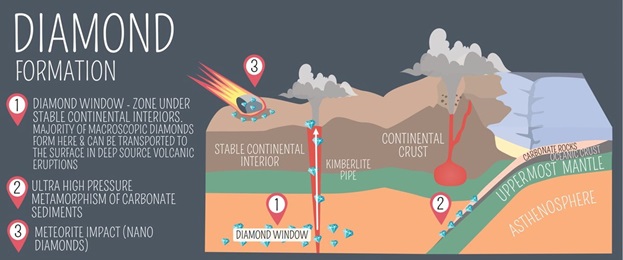
A summary of natural diamond formation occurrences. From the UK Geological Society, 2019.
Diamond Mining
There are four basic types of diamond mining: open-pit mining, underground mining, alluvial mining, and marine mining.
Each of these mining types sources diamonds from either primary or secondary deposits.
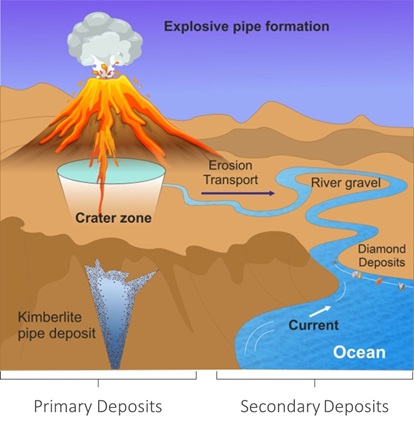
Primary Deposits
The location where diamonds are first brought to the surface is called a primary deposit. Here, diamonds are found in their original host rock. These primary deposits are known as pipes, also called “diatremes”. They are the geological remains of large bodies of diamond-bearing magma that have cut through the earth’s crust in volcanic eruptions.
These diamond-bearing magmas are composed of diamond-bearing rocks, kimberlite, or, in rarer instances, lamproite.
An example of a lamproite diamond pipe is the Argyle mine located in western Australia. This is the main source of rare pink and red diamonds.
Kimberlite Diamond pipes gradually taper as they extend deeper into the earth and resemble carrot-shaped cones; On the other hand, many lamproite pipes are shallower and have champagne glass shape craters.
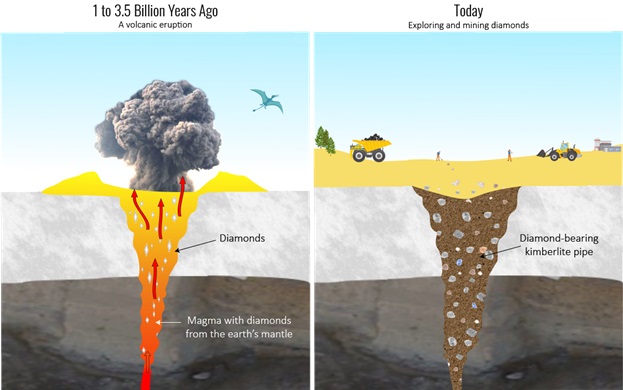
Volcanic eruption creates a kimberlite pipe (a carrot-shaped body of igneous rock that sometimes contains diamonds) and later, erosion and burial below debris can create a challenge for exploration geologists. Pipes, or diatremes, can be the diamond-bearing rock kimberlite, or in rarer instances, lamproite. Diamond pipes gradually taper as they extend deeper into the earth and resemble the carrot-shaped cones.
How Primary Deposits are Mined
Primary diamond deposits are mined using open-pit or underground mining. Open-pit mining is a surface mining technique of extracting diamond-bearing rock from the earth via an open pit. Open-pit mines are used when deposits of diamonds are found near the surface and therefore do not yet require deeper mining techniques to reach them. This method of mining occurs when a pit becomes too deep for further open-pit excavation. Due to the complexity and expenses, this method is mainly only used for a pipe of significant size and profitability.
Today, the five largest diamond mines in the world by measurable reserves (and contain more than one billion carats of recoverable diamonds collectively), are:
Aikhal: Located in Sakha (Yakutia), Republic of Russia, is the world’s biggest diamond mine. It comprises various deposits, including the Jubilee Pipe, Aikhal Pipe, Komsomolskaya Pipe, and Zaria Pipe with an estimated 175.56 million carats of reserves.
Jwaneng: The Jwaneng diamond mine in Botswana is an open-pit mine located 160 miles south-west of Gaborone with an estimated 166.6 million carats in reserves.
Udachny: Also located in the Yakutia region of Russia, with an estimated 164.46 million carats of reserves.
Nyruba: Located in Nyruba, Russia, it consists of three deposits, including Nyurbinskaya Pipe, Botuobinskaya Pipe and Maiskoye Kimberlite Body. They together contain an estimated 132.75 million carats.
Orapa: The Orapa diamond mine in Botswana Is estimated to contain 131.2 million carats.
Secondary Deposits
These secondary deposits are deposits in a secondary location to the primary diamond pipe. These can be eluvial (above the pipe), colluvial (adjacent to the pipe), alluvial (stream and river transported), or marine (along beaches onshore or offshore).
Secondary deposits may be found far from the primary diamond pipe.
Alluvial Deposits
When a primary gemstone deposit is weathered or eroded, more durable gemstones such as diamond may be transported by water or wind and accumulate in a secondary gravel deposit such as beaches, rivers, or deltas. These are called alluvial deposits.
For millions of years, rain and erosion washed away diamonds from pipe deposits into streams and rivers, where they were buried under gravel, sand, and silt, or covered by glacial debris.
During the long journey, the diamonds rolled and tumbled endlessly. Those with large inclusions or structural imperfections tended to break apart. This process is called river sorting. For this reason, secondary deposits generally yield a much higher percentage of gem-quality diamonds than pipes.
Alluvial deposits were the first deposits to be discovered and mined historically. In alluvial deposits, stones are usually loose and easier to mine. This means the scale of the operations is usually smaller than for primary deposits where mining is more difficult. Workers transfer sand and gravel into buckets. Then they sieve the sand and rocks and manually select diamonds. In a much larger operation, various types of mechanical sifters are used. Alluvial operations are often found in Sierra Leone, Angola, and South Africa.
Collection from some alluvial deposits yields over 90% gem-quality diamonds.
Marine Deposits
Marine deposits are a variation on alluvial deposits. Some rivers carried diamonds to the ocean, where they accumulated in marine deposits. They result from the wave action of the ocean, which has concentrated diamonds at the base of the surf zone. Waves arriving at an angle to the coast tend to push the diamonds along the coast, causing the diamonds to stream out from where rivers deposited them at the coastline. In several areas, sea levels later dropped, leaving diamonds on dry land known as beach deposits.
The Atlantic coast of South Africa, Namibia, and other neighboring countries have some of the world’s richest diamond deposits located on their coastal beaches.
Namibian diamonds are known for their large sizes and high clarity, because smaller diamonds with structural weaknesses did not survive the journey from Namibia’s Orange river, out to sea, swept there by current. Even though diamonds are the hardest mineral in nature, minerals tend to break along fractures and inhomogeneities in the crystal structures. So, only diamonds of the highest quality could withstand the forces in a marine environment.
Compared to other diamond producing countries, Namibia produces a higher percentage of jewelry quality diamonds at 90%. This also means the marine deposit has a higher value per carat which is more than four times higher than that of the average South African diamond (Mischo, 2011).
How Secondary Deposits Are Mined
Marine deposits can hold millions of carats and therefore require thorough exploration and research to determine their potential. Research teams first start by gathering data about wave and wind patterns, and the underwater terrain of the seafloor. Computers then create models to show how diamonds may be distributed across the ocean floor. Finally, a group of geologists takes mini-submarines to have a first-hand look before any mining officially begins.
Offshore mining is one of the most challenging methods of mining diamonds. Diamond deposits may be located as far as 60 miles away from the shoreline and as deep as 500 feet below sea level. Crawlers, which are remote-controlled mining vehicles are used where the floor is relatively flat. They move between designated areas gathering up deposits that contain diamonds. Think of it like a vacuum for the seafloor!
In areas where the floor is rocky and uneven, rotary drills are used instead. These drills are 20 feet in diameter and bore into the seabed. Then, a vacuum hose carries the material back up to a ship for treatment and processing.
Artisanal and small-scale mining (ASM) occurs in approximately 80 countries worldwide, and ASM accounts for up to 20% of diamond mining. While there is no set definition for ASM, the Extractive Industries Transparency Initiative
(EITI) defines it as:
“Formal or informal mining operations with predominantly simplified forms of exploration, extraction, processing and transportation. ASM is normally low capital intensive and uses high labour-intensive technology.”
According to this definition, ASM can include men and women working on an individual basis as well as those working in family groups, in partnerships, or as members of cooperatives or other types of legal associations and enterprises involving hundreds or even thousands of miners.
”In some countries, a distinction is made between artisanal and small-scale mining, whereby ‘artisanal’ typically refers to pure manual mining while ‘small-scale’ may have fixed installations or use mechanized equipment.
Countries where artisanal and small-scale diamond mining is prevalent are Angola, Central African Republic, Cote D’Ivoire, DRC, Ghana, Guinea, Liberia, Sierra Leone, and Zimbabwe.
As a sector, artisanal in and small-scale mining can contribute to job creation as a sustainable livelihood and source of wealth creation for rural communities and has significant potential to positively contribute to the economic development of many countries. According to the World Bank, “Though the informal nature and on the whole un-mechanized operation generally results in low productivity, the sector represents an important livelihood and income source for the poverty affected local population. It ensures the existence for millions of families in rural areas of developing countries. About 100 million people – workers and their families – depend on artisanal mining compared to about 7 million people worldwide in industrial mining.”
Where Diamonds Are Found
The search for diamonds has determined that most are derived from kimberlite pipes in the oldest, nuclear portions of the continents, where the basement rocks are older than 1.5 billion years.
The top 5 diamond mining nations are Russia, Botswana, Democratic Republic of Congo (DRC), Australia and Canada. Just these five contribute to more than 60% of the world’s diamond production.
Where Was My Diamond Formed? Where Was My Diamond Found?
Oftentimes, historical, social, or quality connotations are associated with gemstones from a particular locality. In the early days of gem trading, diamonds came from only a few limited sources India (Golconda) and Borneo until they were later discovered in Brazil in the 19th century, and South Africa in the 19th century.
Diamonds now come from multiple sources across the globe, with about 50 accounting for 90% of global supply.
Geographic origin of diamonds has been a challenge for diamond scientists for as long as we have been quantifying diamonds. The properties that make diamond a unique gemstone (the only gemstone consisting of one element, requiring very specific formation conditions) also make it difficult to determine country of origin. Oftentimes, the chemical markers or morphology of the rough crystals that help distinguish a diamond from one source to another are confined to the surface and are polished off when a diamond is faceted. To further complicate the challenge of geographic origin determination for diamonds, there is no set data that links rough or polished diamonds from a specific source based on characteristics, because oftentimes, the characteristics overlap.
Since diamonds are 99.95% carbon the differences in chemical composition are minimal and not necessarily viable for making distinctions between origin. Moreover, diamond deposits vary within the deposit itself.
Researchers can use rare earth elements (REEs) in diamond inclusions to determine information about the type of environment the diamond is formed in, and similarities and differences between deposits. And while these inclusions can tell us a lot about the diamond’s age, and conditions of formation, they are unlikely to point to a specific geographic origin.
Inclusions such as kyanite, sapphire, omphacite, and pyrope almandine garnet tell us the diamond was formed in an eclogite (a type of rock). But eclogitic diamonds only tell us that the diamond was formed in the Earth’s mantle originating from oceanic crust. Inclusions like green chromium diopside, cChrome pyrope garnet, and olivine indicate a diamond was formed in a type of rock called peridotite. Diamonds can be classified by the type of rock they formed it as either P- or E-type, however, both types may be found in the same diamond pipe and are not useful for determining country of origin.
To further complicate diamond origin, diamonds change hands many times from mine to market – from sorting to cutting, to laboratories, wholesalers, and retailers, a diamond can end up in many different locations across the world. Furthermore, there’s no way to know when the diamond was mined.
Diamond Characteristics
Gemological laboratories can use high-tech equipment to determine the internal and external characteristics of a diamond, trace elements, even optical defects at the atomic level.
Sometimes there may be indications of a particular origin. Zimmi diamonds from the Sierra Leone/Liberia border are known for being Type Ib “Canary” diamonds and showing a bright yellow color, or Marange diamonds from Zimbabwe that have a greenish/brownish/grayish cast. But not all Canary diamonds are from Zimmi, nor all greenish/grayish diamonds from Marange. Similarly, diamonds from Argyle in Australia are known for being pink or brown, but pink and brown diamonds can be found in other global deposits. As such, in some cases, there are ways to detect characteristic optical features using advanced spectroscopy. Diamond scientists have identified “Argyle peaks” or “Marange peaks” to indicate the origin of some diamonds, but again, are limited to much overlap between diamonds from different deposits.
Conversely, diamond deposits may be known for producing diamonds of a particular size, clarity, or characteristic. Russian diamonds are known for their fluorescence as they incorporate nitrogen into the crystal lattice as part of their formation. Again, any diamond from any geographic origin can have fluorescence, but there can be trends across deposits in the world.
Conclusion
Every diamond has a combination of characteristics such as inclusion suite, optical defects, trace elements, and other factors beyond the 4 Cs that make it unique as your fingerprint. The variation across individual deposits, and overlap between inclusion and chemical composition, as well as how diamonds are processed mean it is not possible to determine the continent, region, or country-specific origin for a cut diamond of unknown origin through commercially available geochemical, isotopic or spectroscopic methods.
As a result, the diamond industry has developed chain of custody protocols to support origin claims on diamonds, including the Kimberley Process Certification Scheme, the De Beers Best Practice Principles, the Signet Responsible Sourcing Protocol for Diamonds (D-SRSP) and the Responsible Jewellery Council’s consultation for its chain of custody to become applicable to diamonds (RJC, 2017).
Source: Gemological Science International, gemscience.net